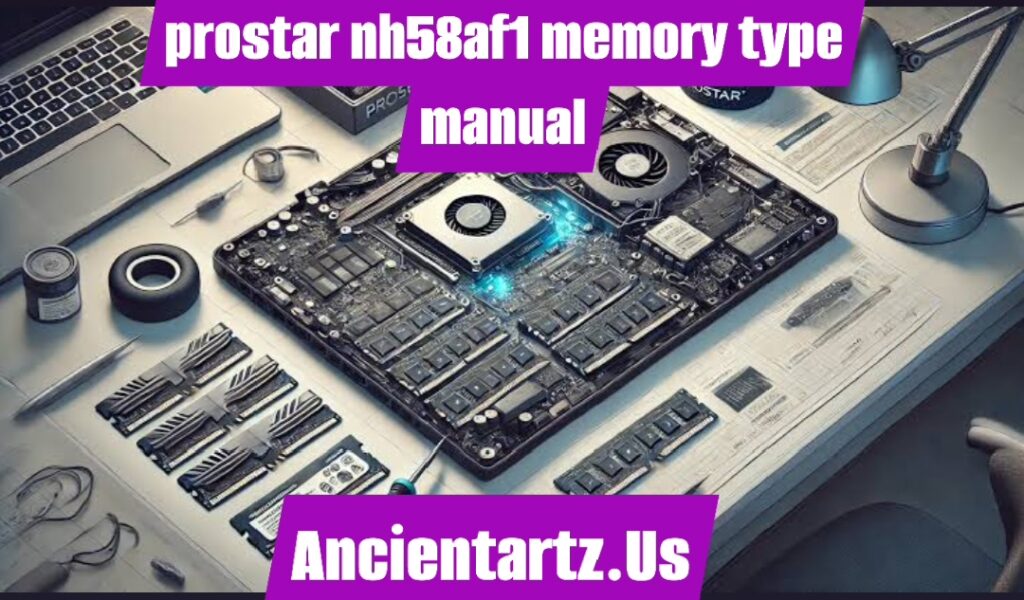Introduction: Exploring the Heart of ProStar NH58AF1—Memory Types and Manual
The prostar nh58af1 memory type manual is a high-performance laptop celebrated for its exceptional computing capabilities, cutting-edge hardware, and flexibility in meeting diverse user needs. At the core of this powerful machine lies its memory system—a fundamental component that determines its speed, efficiency, and ability to handle demanding applications. Whether you’re a tech enthusiast, a gamer, or a professional needing unparalleled performance, understanding the memory types in the prostar nh58af1 memory type manual is crucial to maximizing its potential. This guide dives deep into the ProStar NH58AF1 memory types, their functionalities, and how to optimize them using the manual for seamless operations.
Memory systems in modern laptops are not just about storage space but involve intricate configurations, compatibility requirements, and performance benchmarks. The ProStar NH58AF1 distinguishes itself with support for cutting-edge RAM and storage technologies, providing users with the freedom to customize and upgrade according to their unique needs. However, to harness this potential, familiarity with its memory specifications and adherence to its manual are essential.
In this comprehensive guide, we will explore the various aspects of the ProStar NH58AF1’s memory types manual and provide step-by-step insights from the manual on setup, configuration, and optimization. By the end of this guide, readers will have a thorough understanding of how to leverage the ProStar NH58AF1’s memory system for superior performance and longevity.
Detailed Overview of Memory Types in the ProStar NH58AF1
RAM (Random Access Memory) in the ProStar NH58AF1
The prostar nh58af1 memory type manual is equipped with dual-channel DDR4 memory slots, allowing for an enhanced multitasking experience. DDR4 RAM is renowned for its high data transfer speeds and lower power consumption compared to its predecessors. This laptop supports up to 64GB of DDR4 memory, providing users with the scalability needed for resource-intensive tasks such as 3D rendering, video editing, and gaming. Each slot supports a maximum of 32GB, ensuring flexibility in upgrading.
The manual emphasizes the importance of using RAM modules with matching frequencies to achieve optimal dual-channel performance. Users are encouraged to refer to the laptop’s compatibility chart in the manual to avoid issues such as system instability or reduced speeds. Additionally, the manual provides step-by-step instructions for accessing the memory slots, installing RAM modules, and ensuring proper seating for efficient operation.
Storage Memory: SSD and HDD Configurations
The prostar nh58af1 memory type manual offers versatile storage options with support for NVMe SSDs and SATA drives. The NVMe SSD slots leverage PCIe interfaces to deliver lightning-fast read and write speeds, significantly improving boot times and application load times. The laptop accommodates up to two M.2 NVMe SSDs, which can be configured in RAID 0 or RAID 1 for enhanced performance or data redundancy.
For users who require additional storage, the ProStar NH58AF1 also includes a 2.5-inch SATA bay for traditional hard disk drives (HDDs) or SATA SSDs. This flexibility allows users to balance speed and storage capacity according to their needs. The manual provides clear diagrams and guidelines for installing and configuring these drives, ensuring compatibility and secure installation.
Virtual Memory and Page Files
The prostar nh58af1 memory type manual manual also delves into virtual memory settings, an often-overlooked aspect of system optimization. Virtual memory acts as an extension of physical RAM by using a portion of the storage drive as temporary memory. The manual recommends configuring virtual memory settings to accommodate high-demand scenarios, especially when running applications that exceed the available physical RAM.
Users are guided on how to adjust page file sizes and select the optimal storage drive for virtual memory to prevent system slowdowns. For best results, the manual suggests allocating virtual memory on the fastest available SSD to minimize latency and enhance overall performance.
Configuration and Optimization Tips from the Manual
Step-by-Step Memory Installation
The prostar nh58af1 memory type manual manual provides a detailed walkthrough for installing and upgrading memory modules. Users are instructed to power down the laptop and disconnect it from any power source before proceeding. After removing the back panel using a precision screwdriver, the memory slots are easily accessible.
The manual emphasizes the need for anti-static precautions, such as using an anti-static wrist strap, to prevent damage to sensitive components. RAM modules should be inserted at a 45-degree angle and gently pressed down until the retention clips click into place. For storage drives, users are advised to use the provided mounting screws and brackets for secure installation.
BIOS Configuration for Memory
Post-installation, the manual recommends accessing the BIOS to verify that the new memory has been recognized and is running at the correct speed. The ProStar NH58AF1’s BIOS includes an advanced configuration menu that allows users to enable XMP (Extreme Memory Profile) settings for supported RAM modules. This feature ensures that the RAM operates at its maximum rated speed, delivering optimal performance.
Maintenance and Troubleshooting
The manual provides essential maintenance tips to ensure the longevity of the prostar nh58af1 memory type manual memory components. Regular cleaning of the internal components to prevent dust accumulation and maintaining adequate ventilation to avoid overheating are strongly recommended. Additionally, the manual includes a troubleshooting section addressing common issues such as unrecognized memory modules, slow performance, and system crashes, with practical solutions to resolve them.
Conclusion: Unlocking the Full Potential of ProStar NH58AF1 Memory
The prostar nh58af1 memory type manual stands out as a powerhouse laptop designed for users who demand peak performance and flexibility. Its advanced memory architecture, which includes support for high-capacity DDR4 RAM, NVMe SSDs, and SATA drives, offers unparalleled versatility for a wide range of applications. However, to fully harness its capabilities, understanding the intricacies of its memory system and adhering to the guidelines in the manual are paramount.
By following the detailed instructions and optimization tips provided in this guide, users can configure and maintain their prostar nh58af1 memory type manual to achieve maximum efficiency and reliability. From installing and upgrading RAM and storage drives to optimizing virtual memory settings and leveraging BIOS features, every step contributes to enhancing the laptop’s overall performance.
Investing time in understanding and optimizing the memory system not only improves the user experience but also extends the lifespan of the laptop, ensuring it remains a dependable companion for years to come. The ProStar NH58AF1’s manual serves as an invaluable resource, offering clear and actionable guidance for every stage of memory management.
FAQs: Common Questions About ProStar NH58AF1 Memory Types
Q1: What is the maximum RAM capacity supported by the ProStar NH58AF1? A1: The ProStar NH58AF1 supports up to 64GB of DDR4 RAM, with each of its two slots accommodating a maximum of 32GB.
Q2: Can I use different RAM modules with varying speeds? A2: While it is possible to use RAM modules with different speeds, it is recommended to use matching modules for optimal dual-channel performance.
Q3: Does the ProStar NH58AF1 support RAID configurations for SSDs? A3: Yes, the laptop supports RAID 0 and RAID 1 configurations for M.2 NVMe SSDs, allowing users to enhance performance or data redundancy.
Q4: How do I check if my new memory has been properly installed? A4: You can verify memory installation through the BIOS or the system’s properties in the operating system. The BIOS will display the total recognized memory and its operating speed.
Q5: What precautions should I take while installing new memory components? A5: Ensure the laptop is powered off and disconnected from any power source. Use an anti-static wrist strap to prevent electrostatic discharge and handle components with care.
Q6: Can I upgrade my storage without replacing existing drives? A6: Yes, the ProStar NH58AF1 allows users to add additional storage drives, including a second NVMe SSD or a 2.5-inch SATA drive, without removing existing drives.
Q7: How can I optimize virtual memory settings for better performance? A7: Allocate virtual memory on the fastest SSD available and adjust the page file size based on your system’s workload as recommended in the manual.
Q8: What should I do if the system doesn’t recognize the new memory module? A8: Check if the module is properly seated, ensure it is compatible with the laptop, and update the BIOS to the latest version if necessary.
Also Read This: The Ultimate Guide to Understanding ProStar NH58AF1 Memory Types: Manual and Best Practices



